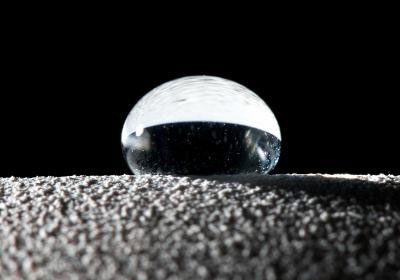Superhydrophobicity: Nature-Inspired Water Repellency
What is Superhydrophobicity?
Superhydrophobicity is a property of surfaces that exhibit extreme water repellency, characterized by water contact angles greater than 150°. In contrast to superhydrophilicity, where surfaces display an extremely high affinity for water, superhydrophobic surfaces are highly non-wetting, causing water droplets to bead up and easily roll off the surface. This phenomenon is inspired by nature, with the most well-known example being the lotus leaf, which remains clean and dry despite growing in muddy environments.

Underlying Principles of Superhydrophobicity
The superhydrophobicity of a surface is governed by two key factors: surface chemistry and surface roughness.
Surface Chemistry
Surface chemistry plays a crucial role in determining the wettability of a surface. To achieve superhydrophobicity, the surface must have a low surface energy, which can be obtained by modifying the surface with hydrophobic chemical groups, such as fluorinated or silane compounds. These hydrophobic coatings reduce the affinity between the surface and water molecules, promoting water repellency.
Surface Roughness
In addition to low surface energy, superhydrophobicity requires a specific surface roughness at the micro- and nanoscale. The hierarchical roughness creates a composite solid-air interface, where air pockets are trapped between the surface asperities. When a water droplet comes into contact with such a surface, it rests on top of the air pockets, minimizing the contact area between the liquid and the solid. This state is known as the Cassie-Baxter state, which is essential for achieving superhydrophobicity.
Fabrication Methods
Various fabrication methods have been developed to create superhydrophobic surfaces, aiming to control the surface chemistry and roughness at the micro- and nanoscale:
- Top-Down Approaches: Top-down methods involve creating micro- and nanostructures on a surface using techniques such as lithography, etching, and laser ablation. These methods allow precise control over the surface roughness but often require specialized equipment and are limited in terms of scalability.
- Bottom-Up Approaches: Bottom-up methods rely on the self-assembly of micro- and nanostructures on a surface. These approaches include layer-by-layer deposition, sol-gel processing, and chemical vapor deposition. Bottom-up methods are generally more scalable and cost-effective compared to top-down approaches.
- Biomimetic Strategies: Biomimetic strategies aim to mimic the hierarchical surface structures found in nature, such as the lotus leaf or butterfly wings. These methods often involve the replication of natural templates using soft lithography or the self-assembly of bioinspired micro- and nanostructures.
Applications of Superhydrophobic Surfaces
Superhydrophobic surfaces have attracted significant interest due to their unique properties and potential applications in various fields:
Self-Cleaning Surfaces
Superhydrophobic surfaces exhibit self-cleaning properties, as water droplets readily roll off the surface, picking up dirt and contaminants along the way. This property has been exploited in the development of self-cleaning windows, solar panels, and building materials, reducing the need for manual cleaning and maintenance.
Anti-Icing and Anti-Frosting Surfaces
Superhydrophobic surfaces have shown potential in preventing ice and frost formation on surfaces. The trapped air pockets on the surface minimize the contact area between the surface and supercooled water droplets, delaying the nucleation and growth of ice crystals. This property is valuable for applications in aerospace, power transmission, and refrigeration industries.
Oil-Water Separation
Superhydrophobic surfaces combined with oleophilicity (oil-loving property) have been utilized for efficient oil-water separation. These surfaces allow oil to selectively permeate through while repelling water, enabling the separation of oil spills and the treatment of oily wastewater.
Drag Reduction
Superhydrophobic surfaces have the potential to reduce drag and enhance the efficiency of fluid transport systems. By trapping air pockets on the surface, superhydrophobic coatings can create a slip boundary condition, reducing the friction between the fluid and the surface. This property is beneficial for applications in marine vessels, pipelines, and microfluidic devices.
Challenges and Future Perspectives
While significant progress has been made in the development of superhydrophobic surfaces, several challenges need to be addressed for their widespread adoption. The long-term durability and mechanical stability of superhydrophobic coatings under harsh environmental conditions remain a concern. Additionally, the scalability and cost-effectiveness of fabrication methods need to be improved for industrial-scale applications.
Future research in superhydrophobicity will focus on developing robust and durable superhydrophobic coatings that can withstand mechanical abrasion, chemical exposure, and extreme temperatures. The integration of additional functionalities, such as antimicrobial properties and stimuli-responsiveness, will expand the scope of applications. Furthermore, the development of eco-friendly and sustainable fabrication methods will be crucial for the widespread adoption of superhydrophobic surfaces.
Further Reading
Nanomaterials, Emerging Separation Applications of Surface Superwettability
Progress in Organic Coatings, A comprehensive review on recent advances in superhydrophobic surfaces and their applications for drag reduction
Journal of Colloid and Interface Science, Superhydrophobic Surfaces: From Natural to Biomimetic to Functional
